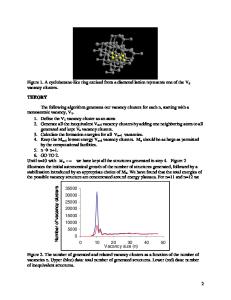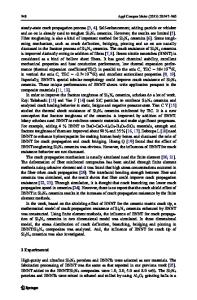Multi-Million Atom Molecular-Dynamics Simulations of Stresses in Si(111)/Si 3 N 4 Nanopixels
- PDF / 2,061,979 Bytes
- 6 Pages / 412.2 x 633.6 pts Page_size
- 99 Downloads / 332 Views
silicon nitride, the potential consists of two-body and three-body terms [3]. The two-body contributions are steric repulsion, screened Coulomb interaction, and charge dipole interaction. Three-body terms account for bond bending and bond stretching. Bulk silicon is described using the Stillinger-Weber potential [4]. At the interface, we have developed a new interaction based on self-consistent linear combination of atomic orbitals (LCAO) electronic structure calculations for the charge transfer from silicon and nitrogen across the interface [5-7]. Validation of SiN Interaction Potential The bulk and Young's moduli for a crystalline Si 3N 4 system at 3.2 g/cc agree with the experimental values to within 10%. For an amorphous system at 2.8 g/cc density, both peak positions and peak height in the static structure factor compare well with the experiments of Misawa et al. [8]. Additionally, the calculated density of states for a-Si 3N 4 agrees well with the density of states obtained experimentally by Loong et al. [9]. Implementation of Large-scale Systems on Parallel Computers A large system is divided into spatial domains and each domain assigned to an individual processor of a parallel computer. This process is called domain decomposition [3,10]. Proper load balancing requires that each domain consists of roughly the same number of particles. In the specific case of a nanopixel (see Figure 1 (a)), the two-dimensional domain decomposition is done in the lateral plane (see Figures 1 (b) and (c)). Therefore, proper load balancing requires that the domains are smaller in the region of the nanopixel and larger in the region where there is only substrate. Information about the coordinates of atoms is passed between domains using message passage interface (MPI) [11 ].
(a)
silicon nitride
1C
Figure 1: (a) Schematics of silicon/silicon nitride nanopixel. (b) Top and (c) side view of two-dimensional domain decomposition for parallel implementation of the molecular dynamics simulation. The arrows in (c) indicate the communication necessary between domains.
370
Preparation of the Systems Si 3 N 4 films deposited on Si(I 11) surface are usually amorphous [12], but a coherent Si( 1 1)/Si 3N 4(0001) interface has also been experimentally observed [13]. A unit cell of Si 3N 4 almost perfectly matches 2x2 periodic cells of a Si(l 11) surface with only a small lattice mismatch (The Si(1 11) is 1.1% smaller). The relative orientation of the two surfaces is chosen for similarity in the symmetry of the two surfaces and to maximize the number of bonds across the interface. First, we shall discuss the preparation of the interface consisting of Si(1 11) and Si3N4 (0001). The Si and Si 3N 4 parts of the systems are placed at a distance of 6 A and then gradually brought together (in increments of 0.5 A, each followed by a steepest descent quench) to a separation distance of 1.5 A. The system is subsequently thermalized at a temperature of 300 K. The Langevin dynamics [14] approach is used during thermalization to achieve a uniform tem
Data Loading...











